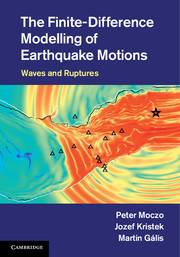Book contents
- The Finite-Difference Modelling of Earthquake Motions
- Dedication
- The Finite-Difference Modelling of Earthquake Motions
- Copyright page
- Dedication
- Contents
- Acknowledgements
- Selected symbols
- 1 Introduction
- Part I Mathematical-physical model
- Part II The finite-difference method
- 5 Time-domain numerical methods
- 6 Brief introduction to the finite-difference method
- 7 1D problem
- 8 3D finite-difference schemes
- 9 Velocity–stress staggered-grid scheme for an unbounded heterogeneous viscoelastic medium
- 10 Schemes for a free surface
- 11 Discontinuous spatial grid
- 12 Perfectly matched layer
- 13 Simulation of the kinematic sources
- 14 Simulation of dynamic rupture propagation
- 15 Preparation of computations and a computational algorithm
- Part III Finite-element method and hybrid finite-difference–finite-element method
- Part IV Finite-difference modelling of seismic motion at real sites
- Appendix A Time–frequency misfit and goodness-of-fit criteria for quantitative comparison of time signals
- References
- Index
14 - Simulation of dynamic rupture propagation
from Part II - The finite-difference method
Published online by Cambridge University Press: 05 May 2014
- The Finite-Difference Modelling of Earthquake Motions
- Dedication
- The Finite-Difference Modelling of Earthquake Motions
- Copyright page
- Dedication
- Contents
- Acknowledgements
- Selected symbols
- 1 Introduction
- Part I Mathematical-physical model
- Part II The finite-difference method
- 5 Time-domain numerical methods
- 6 Brief introduction to the finite-difference method
- 7 1D problem
- 8 3D finite-difference schemes
- 9 Velocity–stress staggered-grid scheme for an unbounded heterogeneous viscoelastic medium
- 10 Schemes for a free surface
- 11 Discontinuous spatial grid
- 12 Perfectly matched layer
- 13 Simulation of the kinematic sources
- 14 Simulation of dynamic rupture propagation
- 15 Preparation of computations and a computational algorithm
- Part III Finite-element method and hybrid finite-difference–finite-element method
- Part IV Finite-difference modelling of seismic motion at real sites
- Appendix A Time–frequency misfit and goodness-of-fit criteria for quantitative comparison of time signals
- References
- Index
Information
- Type
- Chapter
- Information
- The Finite-Difference Modelling of Earthquake MotionsWaves and Ruptures, pp. 246 - 258Publisher: Cambridge University PressPrint publication year: 2014
